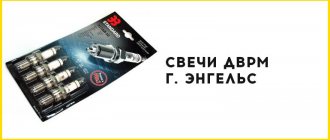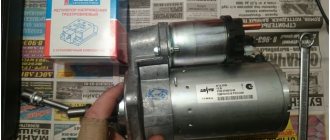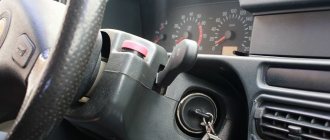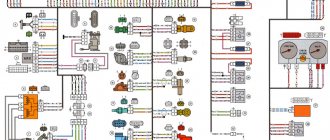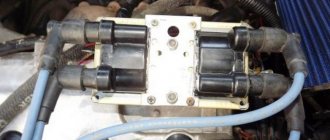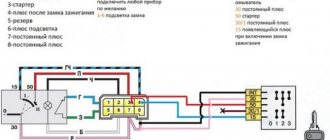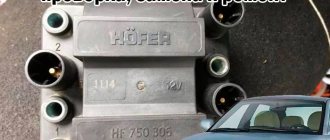Print this article Font size 16
The switch, also known as the ignition switch, plays a huge role in the “starting” system of the VAZ 2114 car. It takes part in the operation of the starter, headlights, turn signals, power windows and other elements of electrical circuits. Today we will talk about the ignition switch of the VAZ 2114, the reasons for its replacement, the dismantling procedure and much more.
Egnition lock
Problem with engine starting and dashboard 2115
Hi all.
I continue the stories of malfunctions and breakdowns in my little spot. So, without having time to eliminate the engine knocking (axial runout of the camshaft), another malfunction appeared.
I'll start with some background. Yesterday I drove it, came home, parked it for the night, everything was as usual. In the morning I had to go on business, it was lightly frosty outside (-7), the car was covered in snow, I decided this time to completely clean it first and then warm it up. So, I cleaned it, sat down, started it without problems, and literally a second later it stalled and no matter how much I tried to start it, nothing worked.
2. I heard somewhere that it may not start due to a broken timing belt. I took off the cover, looked, everything is in order.
3. I looked at the spark plugs and didn’t see anything criminal either.
4. I have the last option left, this is a fuel pump, since lately the fuel level has been either Max or Min. I decided to listen to see if it works. I reclined the seat, put the key in the ignition, turned it over and nothing, no sounds... I disconnected the chip, looked, the contacts are normal. I thought, well, that’s it, screw it, the fuel pump is in trouble and needs to be replaced. And then I remembered one more moment...
5. On the passenger side, in the legs, under the dashboard, there are some relays and fuses, I began to study. I took out the topmost 15 amp fuse, I looked, and it had blown. I reached under the hood and took the turn signal fuse (15 amp), installed it, turned the key, the engine tried to catch, but it wouldn’t start and the starter just started turning again. I looked at the fuse and it was blown again. (Photo 1)
I began to study this problem on the Internet and found one piece of advice that you can disconnect the chip from the fuel pump and try to start it. If the fuse survives, then the fuel pump is damaged; if it is blown, then the problem is somewhere in the wiring. I ended up with the second option. I went to check the wires under the dashboard, and there were a lot of them there for me, I felt them, moved them, looked and decided to start it again, and lo and behold, it started.
But! The story doesn't end there. It starts up fine, but for some reason the dashboard stopped working. There is a backlight, but there is no data: no temperature, no revolutions, no speed, not even mileage, empty! (Photo 2)
It was already late and dark, I left this matter until tomorrow, I really hope that another fuse blew and replacing it solved this problem.
The problem with the dashboard is solved :) I forgot to mention that when I pulled out the turn signal fuse (F16), I didn't get it back, so it didn't work.
Source
Installation of a new larva
To install a new lock cylinder, you will need to follow a few simple steps:
- Unpack the new kit, prepared for replacement, and lubricate the internal moving parts.
- Install a new return spring. Usually it is not included in the standard replacement kit and is purchased separately. When installed correctly, the key should rotate freely back when in the hole.
Installing a new return spring
- Install the pin in the end of the swivel rod.
- Reassemble the door in the reverse order as described in the previous section.
Emergency, the starter does not turn (Solved)
2 months ago) was on a cold one. Who thinks what? Electrical?
Thoughts on the b-pump: I have an internal debate. On the one hand, it is impossible to drive with a non-working pump (there is no gasoline in the combustion chamber), but on the other hand, fuel may well come from the main line under the influence of a pressure difference! That is, it started from the pusher and then, by inertia, the engine itself pulls out of the line. Tell me I'm wrong =((
===========*=*============ Day 4. I went out to try, as a result, the first start with half a turn, I turned it off and that’s it, attempts to start it failed. I am leaning towards the retractor relay (because this is the only part that can work according to the principle that explains the situation as simply as possible, namely, the return spring has screwed up...
===========*=*============ Day 5. The situation has already begun to get out of control, namely: I leave work at 21:15 (the car was parked from 9:50, that is, idle time for almost 12 hours, everything that could reject it should have done it) and at least henna. Not only that, in the morning I was afraid to even go to a gas station - I poured
4 liters from a canister and was driving with the BC showing a decrease from 5 liters to 0 several times (yes, I have a problem with the fuel sensor, I haven’t gotten around to it yet) and thinking that stalling in the middle of the highway or in the left lane in the city would be very cool, don’t leave yet. Thanks to the man in the cruiser for being the only one standing in the parking lot at the gribanal. I even wanted to help push him manually out of a parking space. In general, I got home with 10 liters of gasoline, according to bk xD
Day 6. Finally I went to the electrician and found him 5 minutes before lunch. He was not happy with the fact that this was my fourth day with the starter. Service station "Quartet" in Gatchina - I recommend it! And here’s why: the man removed the starter from the car, together with me in his car he went to a friend’s modest workshop at the car wash for “starter repair”, etc., they quickly found brushes for me (so that I wouldn’t have to go shopping for another two days with a chance to buy a new starter ), because the old ones were almost completely erased (actually the basis of the problems!), they lubricated the rotor (the engine was dry as a rag in the trunk) and after checking, they loaded the electrics into the car. The guy went on business, dropping me off almost home. In the evening I calmly arrived at the designated time and everything was installed in 10 minutes. During the installation process, I found out exactly where the external temperature sensor is located (I want it to work, but my search in Murzilka was unsuccessful) and the belt whistle was eliminated! *The fact is that I did not have an adjusting “corner”. At Piter-lad they asked for 1000+ rubles for its installation and work (at that time I didn’t know what it was) and to leave the car until the morning, because they didn’t have the parts. Having politely refused, I decided to ride with an unpleasant, but free sound effect. * The electrician casually found a used “corner” lying around, got two bolts and nuts for it from a colleague and screwed it into its rightful place (I thought he would just hand it to me).
Result: with the starter 600 RUR starter repair 600 RUR starter brushes 200 RUR Belt adjustment as a gift!
Source
Preparation
It is necessary to prepare spare parts and other equipment for work. A new ignition switch will be needed. It is quite easy to find original parts and analogues on the Internet, but it is worth considering that it is advisable to purchase the lock “assembled”.
Catalog number of the original VAZ 2114 ignition switch: 21103704010. Approximate price: 500 rubles for a used part and 1200 for a new one.
As a replacement, you can use analogues with numbers: 09401, 24370407. Approximate price: 1000 rubles (new part).
In addition to the lock itself, you will need the following tools:
Before you begin, you must also remove the steering column cover and steering column switches.
Ignition switch VAZ 2115 injector 8 valves does not respond to engine starting
When did this problem appear?
I have a siglanc, but I don’t use it.
If the alarm is completely turned off, then the problem should go away on its own?
Are there any other options for why the car won't start?
When you turn the key in the lock, does the starter interlock relay activate?
Even if it clicks, its contacts may be burnt, because they are in series with the contact group of the lock, also in the power circuit of the traction relay.
Although it’s also not clear, I can start it directly, I can start it with a pusher, but I can’t start it with the key as it should be.
it turns out that it’s the same as what Yurik 999 advised
Yurik 999
very good advice!
I just added.
All that remains is to make a control and run through this diagram if the ECU is 7.9.7 or 7.2:
By naming the topic, for example, “The starter does not turn with the key,” don’t you think it will be clearer?
Central lock designs
Advanced car central locking configurations include:
- Control block;
- electrical supply cables;
- input sensors;
- remote controls;
- actuators (actuators);
- additional devices (window closers, electric sunroof, electric trunk locks, fuel hatch lock).
In basic configurations, the central locking control unit, after turning the key, removes the locks from the locks of all doors, activating the actuators.
The same functions are performed by the car alarm control unit, which is devoid of actuators, so harmonizing two systems built on different principles becomes the main task of the installer.
The basic diagram of connecting electrical circuits is the same for all types of central locks, car alarms, only the design of the control unit, actuators, and the number of pins for connecting additional devices change.
General diagram of connecting the alarm to the central locking
Important elements of the central lock, in addition to the control unit, are door limit switches (“limit switches”) and microswitches that fix the position of the key and locking mechanisms. These elements must be connected to interior lighting and car alarms.
Differences in designs of actuator drives (electric, pneumatic), types of control (negative, positive pulse, variable polarity) are important for understanding the theory. In practical work, the car enthusiast focuses on a specific model of central locking.
VAZ 2115 does not respond to the ignition key
What to do if the car does not respond to the ignition key?
Moreover, with all this, it is often removed from the alarm and installed on it without any problems (so everything seems to be in order with the battery), and the key clicks in vain in the lock, preventing the car engine from starting. There are other situations: it seems to have started, turned on something insignificant - the wipers, for example - the engine stalls, the key is no longer perceived. The worst thing is that there can be a million reasons, and almost all of them are electrical. And electrics are almost like the East: a delicate matter and not everyone understands.
We won’t mention primitive reasons like not filling up with gasoline or ignoring a burning check - even a person who just received his license yesterday will think about and remember this first. Let's talk about more significant ones that require more careful attention.
The car does not respond to the ignition key in most cases for fairly simple reasons that you can easily fix on your own. A little less often, but also often - for more complex ones, requiring some knowledge, time and financial investment from you. Some can only be handled by a professional - you will have to come to terms with this and prepare the appropriate fee. But first, you need to check what even a person far from mechanical and electrical can do.
How to set the ignition yourself?
Precise ignition adjustment on the VAZ 2115 injector is performed using a special strobe light. If this is not possible, you can set the ignition on the VAZ by spark.
To do this, follow these steps:
- First of all, the engine is warmed up until it reaches operating temperature.
- The distributor does not need to be removed, but only relaxed.
- You need to remove the central wire from the distributor.
- The piston in the 1st cylinder must be at TDC (the marks are set differently on 8 and 16 valve engines).
- Now you need to hold the short-circuit wire with your left hand and turn on the ignition.
- Use your right hand to adjust the distributor counterclockwise, while keeping the high-voltage wires above the metal.
- Then similar actions are performed, turning the distributor clockwise until a spark appears.
- At this point, the alignment ends, and the distributor is fixed in its regular place.
With the ignition set correctly, the car will operate without interruption with optimal fuel consumption and maximum power.
Simple and fast
The easiest way to deal with the power source is the battery. Sometimes it tends to run out of charge, and if it started to run out recently, you might not have noticed it yet. If you have a voltmeter tester, checking is a matter of seconds. If it is not there, you can use the old-fashioned method (although it is not very approved by firefighters): remove the wires from the terminals and rub them against each other.
There is a spark (which is why the firefighters are protesting) - the battery is working. If you don’t want to violate safety rules, just listen to the car’s reaction: a slight jolt at the first stage directly indicates a low battery.
The second reason, equally common and easy to eliminate, is oxidation of the terminals or their contamination. Clean them with a wire brush (probably lying in the trunk) - and the car will start.
The next thing to check is the fuses
. They often burn out, and most more or less modern cars have an ignition control. The circuit is removed from the glove compartment and it becomes clear which one needs to be checked; if it burns out, replace it, and that’s the end of it.
More severe cases
It’s a little sadder if the ignition switch itself is covered. After the initial check and cleaning, the key is inserted and turned to the first position. At the same time, the warning lights and instruments on the dashboard should light up. If there are no signs of life, electrical enthusiasts can ring this unit themselves, or even replace it without outside help. The rest are looking for someone to attach the cable to and go to the service station: they may have to disassemble the half-torpedo in search of the cause (which could be any frayed wiring. Then at least you won’t have to change the lock).
Another component available for checking is the starter itself. To make sure everything is fine with it (or vice versa), you will need an assistant and, again, a tester. One person turns the key, the second holds the wire of the device on the wire that supplies voltage to the starter. The main thing here is to position yourself so that the rotating part does not catch the controller if the starter is normal. If there is voltage, but the starter does not respond to it, it will have to be repaired.
If the starter spins but there is no feedback, a completely different story begins:
If you have checked all this, found and corrected some shortcomings, and the car still does not respond to the ignition key, you will have to accept the inevitable and drag it to a car service in tow. To do this, you can use a neighbor in the garage or just an acquaintance. Or you can use a tow truck, but this will cost a certain – and considerable – amount. Then a professional electrician at the nearest service center should look for the reason for the stubbornness of your car - an amateur has very little chance of this.
During the operation of vehicles, regardless of the type of engine installed, a common malfunction is starter failure, as a result of which it is not possible to start the engine after turning on the ignition. In other words, the car starter does not respond to turning the key in the ignition switch.
In such situations, after turning the key, instead of cranking the engine crankshaft, the starter is completely silent, buzzes or makes clicks, but does not turn the engine. Next, we will look at the main malfunctions when the starter does not respond in any way to turning the key in the ignition, as well as other reasons that may cause the starter to not work.
We will answer immediately. As a rule, problems can be with the protective alarm, starter or battery. More often than not, the battery fails (discharges) and as a result, when you turn the key, the car does not react at all, the starter clicks and the engine does not start. Read more about the breakdowns below.
When replacement is required
Ignition switch kit
There are several basic situations when a car owner may urgently need to replace a unit. The reasons for the malfunction of the VAZ 2114 ignition switch include:
- Mechanical failure of keys;
- Lost key;
- Damage to the lock as a result of an attempted theft;
- Broken ignition contacts.
Why does the starter not respond to turning the ignition key?
After turning on the ignition, power from the battery is supplied to the on-board electrical systems and the computer (if equipped). If there is an immobilizer (standard or an installed security system), this occurs only after the tag is recognized. When the key is turned to the start position or the start button is pressed, the contacts of the solenoid relay are closed, resulting in power being supplied directly to the starter. At the same time, the starter overrunning clutch (Bendix) engages with the flywheel crown, setting it in motion and ensuring the engine starts. Often, switching is carried out through an additional starter control relay, which removes the load from the lock.
Ignition switching circuit
If a problem arises at any of the above stages, the car will not start: you turn the ignition key and the starter is silent. As a rule, the reasons for this behavior lie in:
More information about why the starter does not work with the ignition key can be found in the table.
The starter does not work from the ignition key: reasons
| Problem | Cause of malfunction |
| Starter motor faulty | The electric motor fails due to overheating, short circuits in the windings, wear of the brush assembly, and jamming of the gearbox. |
| The circuit from the ignition switch to the starter solenoid relay is faulty | Wiring break or short circuit. Often occurs after repairs, installation of additional equipment, or as a result of mechanical wear during long-term use. |
| Damage to the ignition switch (deformation of the cylinder) | Deformation due to overheating, which in turn occurs due to poor contact. Damage is also possible due to the mistaken use of an inappropriate key. |
| Electrical malfunction of the ignition switch contact group | The layer of oxides formed on the contacts prevents the flow of current. Also, the contacts may move away due to deformation of the rotary sleeve on which the mating parts are attached. |
| Start blocking by installed alarm | A voltage surge in the on-board network or loss of power (disconnection of a terminal or discharge), failure of a transistor or microrelay responsible for turning on the start line in the base unit of the security system. |
| Immobilizer malfunction/decoding | Voltage drops and sudden loss of power (battery discharged or terminal removed), software failure, failure of microelements. If the immobilizer does not recognize the mark, the starter does not turn after turning the ignition key, and the immobilizer symbol usually lights up or flashes on the indicator panel - an image of a car with a key or lock. |
| Failure of the solenoid relay | Burnout or short circuit of the winding as a result of overheating due to the flow of increased current or being under load for an extended period. The root of all problems is usually oxidation of the internal and external contacts of the solenoid relay. |
| The limit switch for the automatic transmission selector position, the brake pedal for an automatic transmission or the clutch for a manual transmission is faulty | Sensors fail due to mechanical wear, and their wires and terminals can oxidize or fray. Because of this, the ECU does not allow the starter to start. |
| Starter relay failure | If the starter control relay is stuck or shorted, it cannot supply power to the control terminal of the solenoid relay. |
| Poor “+” contact from the battery on the starter | The power contact terminal oxidizes under the influence of moisture and heat. The nut that holds it to the starter stud can come loose due to vibrations. |
| Poor ground contact at the battery terminal, car body or engine | Due to oxidation, the contact of the ground wire deteriorates; the same thing happens when its nut is unscrewed under the influence of vibration. In this case, the passing current may be enough to turn on the on-board network and the ECU, but not enough to drive the starter electric motor. |
Possible reasons for failure of the ignition module
Before repairing the main part in the car’s ignition system, you need to understand the nature of the problem. To do this, the consumer must be aware of the signs of a malfunction, as well as the causes of the breakdown.
The main reasons for device failure
Causes of problems:
- The ignition system uses spark plugs that do not match the vehicle parameters. They may not have the gap specified by the manufacturer. Also, the spark plugs themselves may not be working or dirty; this can be determined by visual diagnostics. If there are traces of carbon deposits on the devices, they must be removed.
- Malfunctions in the operation of the MH can arise as a result of frequent spark checks. At the time of diagnosis, a high load is placed on the device. If it appears frequently, it will lead to equipment failure or incorrect operation.
- The ignition module in the VAZ 2114 operates with the high-voltage cables disconnected. This also leads to device failure. The products themselves may be damaged, which affects the functioning of the engine as a whole.
- The device operates under severe vibration conditions. Their impact may be due to poor quality fixation of the module in the seat. As a result of vibrations, the factory soldering inside the equipment structure is damaged. This leads to its incorrect operation.
- The contact inside the plug with the low-voltage cables is broken.
- Initial use of a defective device or module with poor build quality. This factory defect can only be eliminated by replacing the mechanism; repairing the equipment is pointless.
- Moisture getting inside the case. This problem is unlikely, but exposure of the device to liquid may cause it to short out and break.
Signs of coil malfunction
The main symptoms of a malfunction in the VAZ 2114 ignition module:
- Difficulties arise when trying to start the engine. Starting the car engine may be difficult due to the fact that there is no spark on a spark plug or several.
- When idling or parking with the internal combustion engine running, the speed of the power unit floats. Their change is not associated with pressing the gas pedal and other third-party factors. This happens randomly.
- There are dips in the power of the car's engine. This is especially felt when driving uphill or sharp acceleration. Problems can also occur when driving on a flat road.
- Several cylinders stopped working. Usually these devices operate in pairs, so elements 1-4 or 2-3 could fail. Non-working cylinders may be indicated by “triple movement” of the engine.
- A “Check Engine” warning light appeared on the dashboard.
If the ignition module malfunctions, problems will appear not only in engine operation, but also when starting it.
The “Simple Opinion” channel, using the Lada Priora car as an example, spoke in detail about the symptoms that appear in the operation of the ignition modules.
This is interesting: Replacing the VAZ-2112 fuel filter 16 valves - photo and video
What to do if the starter does not turn the engine from the ignition switch
If when you turn the ignition key the car does not start, and nothing happens at all, in some cases you can correct the situation by supplying power to the starter, bypassing the lock. This solution is suitable for cases where the electric motor itself and the solenoid relay are in good working order. In this case, you need to proceed according to the following algorithm:
Control wire terminal
An alternative to the same method is to supply power to the starter control terminal directly from the positive terminal of the battery. This can be done using any insulated wire, for example from a cigarette lighter wire kit.
The lack of response of the starter to direct power supply indicates its breakdown, failure of the electric motor or the solenoid relay. To diagnose the starter, you need to disassemble the starting unit, inspect the brush assembly, armature and stator windings. This is not easy to do in the field and without a multimeter, so you need to push the car and get to the garage or service station.
When the starter turns directly, but not from the key, then the starter itself is fully operational, and the problem lies in the electrical circuit from the key to the starter. To determine the location of the breakdown, you need to follow the instructions given below.
How to look for the reason if the car does not respond to the ignition key - instructions:
How to start the engine by jumping the starter directly: video
What to do if the starter does not respond to the ignition key: video
Burnt contacts from the ignition switch are a common occurrence on VAZ cars
Starting problems, if the ignition key does not turn the starter due to an immobilizer or alarm, are difficult to eliminate in the field. The same goes for wiring problems that require disassembling the panel. In such cases, it is better to contact a qualified auto electrician.
Bulb
The principle of triggering the light elements in the cabin is simple. There are limit switches on the body pillars on all sides.
When the door is opened, this small part causes the contact to open, which gives a signal to turn on the lighting. When you open the door on 2114, only the main lamp turns on. Frequent opening of the door and constant activation of the light bulb leads to its gradual wear.
As soon as the life of the light bulb runs out, it burns out. You can check the integrity of the light bulb yourself. It is enough to lift the plastic cover of the main light source and the insides of the illuminator will be before your eyes.
It's a little more difficult to change. It is necessary to use a screwdriver to pry off the body of the fisheye, and then remove the wire block. Next, press the latches on both sides of the case and remove the r5w base.
If after the replacement procedure the interior lighting of the VAZ 2114 does not work, check the wiring.
Frequent malfunctions on popular cars
In most cases, the starter does not turn when the ignition key is turned due to oxidation and mechanical damage to the wiring. If there is poor contact with the “+” terminal of the battery, the control relay or ground, the starter does not receive enough current to crank the engine . Therefore, first of all, you need to look at the contacts in the engine compartment and check for voltage at the terminals with a tester. The most common malfunctions of specific car models, due to which the starter does not respond to the ignition key in the table.
| Why does the starter not work from the ignition key on popular car models? | |
| Auto | Weakness |
| VAZ 2110, 2111, 2112 | Wires of the central locking and ignition switch, which melt due to power surges. |
| VAZ 2108, 2109, 21099, 2113, 2114, 2115 (Lada Samara) | Oxidizing contacts of the control relay located in the engine compartment above the VUT, as well as the wiring extending from it. |
| VAZ 2101, 2102, 2103, 2104, 2105, 2106, 2107 (Classic) | The contact “nickels” of the solenoid relay often burn or oxidize. The contact group of the ignition switch fails. On later models, for example, 2107, problems with the control relay are similar to Samara (see above). |
| Niva | On old Nivas (before 21213), the ignition switch contacts burn and oxidize. On newer ones (after 21214), the starter control relay, located under the hood near the brake fluid reservoir, often fails. There is a drainage tube located nearby that drains water from under the glass, moisture from which gets onto the relay, which leads to oxidation of its contacts. |
| Lada Priora | Immobilizer problems due to which it does not see the key. |
| Lada Kalina, Lada Granta | Failure of the immobilizer, blocking the start, malfunctions in the contact group of the ignition switch and failure of the additional starter relay K3 in the fuse block. |
| UAZ | Malfunction of the 5-pin starter control relay and solenoid relay. |
| Gazelle | Poor contact of wires and failure of the starter relay. |
| Peugeot 307 | Solenoid relay fuse F8 blows, poor ground contact. |
| Kia Sid | The limit switch of the automatic transmission selector, which determines the P and N positions, is faulty. There may be poor contact at the starter terminals or at the point where the ground wire is attached to the body. |
Examination
It is a mistake to assume that damage to high-voltage wires does not in any way affect the condition of the module itself. Many people think of simply replacing high-voltage elements, but in reality they will still have to change the module.
This is explained by the fact that damaged or defective wires direct the wrong current, the configuration of which does not correspond to the necessary parameters. As a result, the spark hits inaccurately or ineffectively, causing the module to burn out and become unusable.
In general, the best option for checking the ignition module on a VAZ 2114 is to use an oscilloscope. But, firstly, not every driver has it, and secondly, few people can use them. Therefore, we will carry out the check using improvised means:
- 12-volt light bulb;
- Tester (available for little money at any auto parts store).
Let's start with preliminary manipulations with the accompanying elements of the ignition module.
- Check the wiring harness. It is disconnected and the voltage indicator is checked.
- To do this, fix the tester on contact A, and connect the other terminal to engine ground.
- In normal condition, the voltage reading will be 12V.
- If there is no voltage, most likely the fuse has blown.
- If everything is fine, transfer the terminals of your tester to contacts A and B, start the car. In this case, the starter should turn and the 12-volt light should blink.
- In the absence of these phenomena, we can talk about the presence of a break in circuit A of the contacts.
Next we go to the ignition module itself.
There are several ways to check the condition of your unit. Therefore, let's look at each of them.
- Set the tester to ohmmeter mode. Use it to measure the resistance on the high-voltage lines going to cylinders 1 and 4, and then, by analogy, to the wiring of cylinders 2 and 3. In normal condition, the device will give you readings from 5.2 to 5.5 ohms.
- Give the device a gentle tug. Thus, you will shake the wiring block and the module. Moreover, this must be done in the operating mode of the power unit. If the device works without obstruction when loosened, everything is fine, you are lucky. If not, you will again have to study the condition of the wiring.
Third way
The third method is considered the simplest, since it involves replacing your device with a similar one that works exactly. But to do this, you have to find a full-fledged twin. We are talking about an ignition module from a car similar to yours in terms of year of manufacture and power unit used. It’s just that 1.5-liter engines have modules, and 1.6-liter engines have coils.
But to replace a module with a module, you will have to first dismantle yours. This is done as follows:
- Remove the negative terminal from the battery, which will allow you to turn off the power to the car;
- Disconnect four high voltages from the ignition module;
- Disconnect the wire block. To do this, you need to release the special clamp that holds the block on the module;
- Next, unscrew the three nuts. With their help, the module is held on the bracket;
- There are three long pins on the bracket, from which the module can simply be pulled off.
Having dismantled your module, you can put another unit in its place, thereby verifying the functionality of that one and the malfunction of yours.
Answers to frequently asked questions
How can you tell if the starter relay is not working?
To determine whether the starter relay is working, apply power from the positive terminal of the battery directly to the control contact of the relay. After this, a click should sound; if it is faulty, there will be no sounds.
How to check whether the starter is working or not?
To check the serviceability of the starter itself, you need to apply current to it directly by connecting the power wires of the retractor relay (thick wire from the battery) and the electric motor (stud with a thick wire from the retractor to the starter). A working starter should start moving.
What to do if the starter does not work after turning the ignition key?
First, make sure there is voltage at the battery terminals. If you don’t have a tester, this can be done using a 12 V lamp. Then try to apply voltage directly to the starter: use a screwdriver to close the pin to which the wire from the battery goes and the control contact located nearby. If there is no reaction, check the quality of the contacts of the terminals on the battery, the ground contacts (with the body and the engine) and the contacts of the starter itself by cleaning and tightening the terminals. If the battery is discharged or the starter is faulty, you need to start the car with a pusher (manual transmission) or tow it to the repair site.
Fuse
There are fuses in the lighting circuit. The lamp is activated and voltage is supplied to the lighting lamp only if the fuse is working properly. In different years of model production, two different types of mounting blocks were installed on the car from the factory. Note the location of the dome light fuse on each of them. First, let's look at the location of the fuse in the mounting block of the new model. This element is also responsible for the operation of the brake light.
The power of the interior pre-illumination is 7.5 Amps. To quickly replace a blown element, it is recommended to carry with you a spare set of fuses of all capacities.
In the old-style mounting block, this element is located a little differently - it is the 7th in a row from left to right. The power of the element in this version of the block is 10 Amperes. In addition to interior lighting, a circuit to the brake light goes through this element. This may help when trying to diagnose a malfunctioning ceiling light.
If, after replacing a burnt-out part, the light in the interior of the VAZ 2114 does not come on, you should look for the reason in the wiring and the light bulb.

